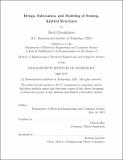| dc.contributor.advisor | Daniela Rus. | en_US |
| dc.contributor.author | Chounlakone, Mark. | en_US |
| dc.contributor.other | Massachusetts Institute of Technology. Department of Electrical Engineering and Computer Science. | en_US |
| dc.date.accessioned | 2019-11-22T00:02:24Z | |
| dc.date.available | 2019-11-22T00:02:24Z | |
| dc.date.copyright | 2019 | en_US |
| dc.date.issued | 2019 | en_US |
| dc.identifier.uri | https://hdl.handle.net/1721.1/123015 | |
| dc.description | This electronic version was submitted by the student author. The certified thesis is available in the Institute Archives and Special Collections. | en_US |
| dc.description | Thesis: M. Eng., Massachusetts Institute of Technology, Department of Electrical Engineering and Computer Science, 2019 | en_US |
| dc.description | Cataloged from student-submitted PDF version of thesis. | en_US |
| dc.description | Includes bibliographical references (pages 81-82). | en_US |
| dc.description.abstract | Sensor integration for soft structures can be a daunting task. Conventional sensors such as encoders are often only useful for detecting the motion at joints between rigid structures. Soft structures on the other hand require more customized sensing systems to capture the full articulation of a motion or position. These customized sensing systems often consist of flexible sensor arrays that can measure local mechanical deformations. Often times these sensors have complex fabrication processes and require unique design solutions for specific applications. Here we explore the use of knitted strain sensors in soft structure sensing systems. A low-cost method for fabrication of a hand position tracking glove is presented as an example. | en_US |
| dc.description.statementofresponsibility | by Mark Chounlakone. | en_US |
| dc.format.extent | 82 pages | en_US |
| dc.language.iso | eng | en_US |
| dc.publisher | Massachusetts Institute of Technology | en_US |
| dc.rights | MIT theses are protected by copyright. They may be viewed, downloaded, or printed from this source but further reproduction or distribution in any format is prohibited without written permission. | en_US |
| dc.rights.uri | http://dspace.mit.edu/handle/1721.1/7582 | en_US |
| dc.subject | Electrical Engineering and Computer Science. | en_US |
| dc.title | Design, fabrication, and modeling of sensing, knitted structures | en_US |
| dc.type | Thesis | en_US |
| dc.description.degree | M. Eng. | en_US |
| dc.contributor.department | Massachusetts Institute of Technology. Department of Electrical Engineering and Computer Science | en_US |
| dc.identifier.oclc | 1127584466 | en_US |
| dc.description.collection | M.Eng. Massachusetts Institute of Technology, Department of Electrical Engineering and Computer Science | en_US |
| dspace.imported | 2019-11-22T00:02:23Z | en_US |
| mit.thesis.degree | Master | en_US |
| mit.thesis.department | EECS | en_US |
